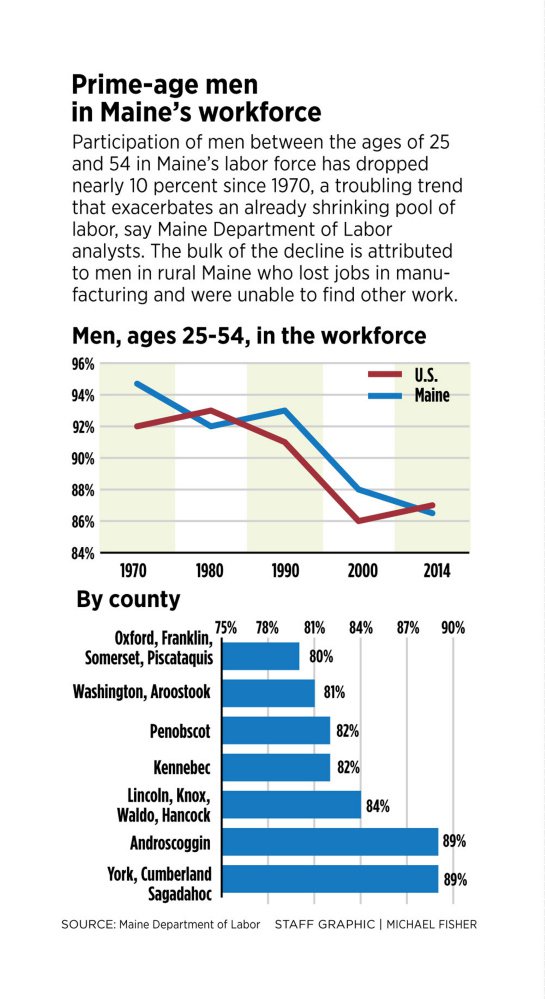A growing share of men in the prime of adulthood are dropping out of the labor force in Maine, adding to the state’s loss of able-bodied workers from the aging population and lack of in-migration.
Labor force participation of males age 25 to 54 has declined over the past four decades in Maine, with a sharp drop-off beginning in 1990, according to a report by the Maine Department of Labor’s Center for Workforce Research and Information. The labor force is the combined number of employed workers and active job-seekers.
The share of “prime-age” males in Maine who are working or looking for work declined from nearly 95 percent in 1970 to slightly more than 86 percent in 2014, the report says. The primary reason is the loss of manufacturing and the middle-income jobs it created for workers who lack higher education. Many men who were laid off from such jobs appear to have given up on finding new employment, it says.
Nationally, a similar trend occurred, although the sharpening decline started earlier, around 1980, and male participation began to rebound more than a decade ago, unlike in Maine.
The report dispels any optimism that the majority of men leaving the labor force in Maine were busy seeking a higher education or raising children full time. While those men do exist, the report found that 93 percent of the 25- to 54-year-old males who were not in the labor force also were not in school, and 75 percent had no children in their homes.
The report’s authors say it is essential to Maine’s economy that the state come up with ways to bring more of those prime-age men back into the labor force.
“In the years ahead, the labor market is expected to tighten considerably because the number of baby boomers who will be retiring exceeds the number of young people who will begin working,” the report says. “For this reason, it imperative that we find ways to engage prime-age men who are not in the workforce by helping them gain the education and job skills employers need.”
Glenn Mills, chief economist at the Maine Center for Workforce Research and Information, said the drop in labor force participation is specific to males.
“The labor force participation among women has not been going down at the rate that it has among men,” Mills said.
Reasons why female participation has remained more stable include fewer stay-at-home moms, births and marriages, Mills said, adding that labor force participation actually has increased among women 55 and older.
MANUFACTURING IMPACT
Geography and education both play critical roles in the labor force decline among men, according to the report. Men without high school diplomas have been hit the hardest, as have those in rural areas.
The trend of declining participation among men without an education beyond high school coincides with the decline in manufacturing jobs, the report says. Historically, the manufacturing sector provided large numbers of production, transportation and repair jobs that did not require post-secondary education but offered middle-income wages.
“The decline of textile mills, shoe shops, paper mills and other forest-products industries, and other types of manufacturers left a void of opportunity for many men whose experience is not in demand in such well-paying, hiring sectors as health care and professional services, nor in the modern manufacturing environment that increasingly involves complex processes and requires higher education and skills,” the report says.
Areas of the state that relied most heavily on manufacturing for employment have seen the greatest losses in labor force participation among prime-age males. From 2012 to 2014, it was lowest in Oxford, Franklin, Somerset and Piscataquis counties, followed by Washington, Aroostook and Penobscot counties, the report says. Meanwhile, participation was highest in York, Cumberland, Sagadahoc and Androscoggin counties.
Mills noted that Androscoggin County’s relatively high immigrant population has helped it buck the statewide trend of a declining and aging labor force. “Androscoggin County is one of the younger counties, and I believe it has a lot to do with the Somali population,” Mills said. “It’s true that our lack of diversity (statewide) is the huge reason that we’re in this place.”
Economists have been warning for years that Maine is headed for a significant labor shortage that could spell trouble for its economy and opportunity for tomorrow’s job-seekers. The exact size of the shortage remains unknown, but predictions that it will occur are based on simple math.
In 2012, the number of Maine residents between the ages of 45 and 64 totaled roughly 411,000. Most members of that group are expected to exit the labor force by 2032. There were 302,000 residents under age 20 in 2012, most of whom are expected to enter the workforce by 2032.
Even if none of those young people left the state, the aging of Maine residents alone would generate a shortfall of up to 109,000 workers – a significant problem in a state where the civilian labor force totaled about 689,600 in August.
In March, a Portland Press Herald analysis of state unemployment data found that Maine’s shrinking labor force appeared to be a key factor driving the decline in the state’s unemployment rate. Maine’s seasonally adjusted unemployment rate dropped to 3.6 percent in February, its lowest rate at that time since March 2001, according to the labor department. However, Maine had roughly 3,300 fewer employed workers in February, a decline from about 653,000 a year earlier. The unemployment rate went down because the size of the state’s labor force decreased by 11,500 to 673,700 during the same period. Maine’s unemployment rate then fell even lower, to 3.4 percent in March and April, before rising gradually to 4 percent in August, the most recent month available.
J. Craig Anderson can be contacted at 791-6390 or at:
Twitter: jcraiganderson
Send questions/comments to the editors.





Success. Please wait for the page to reload. If the page does not reload within 5 seconds, please refresh the page.
Enter your email and password to access comments.
Hi, to comment on stories you must . This profile is in addition to your subscription and website login.
Already have a commenting profile? .
Invalid username/password.
Please check your email to confirm and complete your registration.
Only subscribers are eligible to post comments. Please subscribe or login first for digital access. Here’s why.
Use the form below to reset your password. When you've submitted your account email, we will send an email with a reset code.